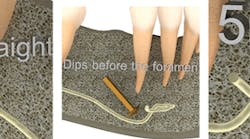By Charles Blair, DDS, and Jim Philhower
You are taking a large pay cut!
There are about 11 PPO plans sold for each indemnity plan. The average PPO discount is about 25% to 35% from a dentist's full fee schedule for participation. Unfortunately, many dentists never take the time to look at the full table of fees when they sign the contract. They may look at their top codes, primarily crowns and a few preventive procedures. On average, 80% or greater of production comes from 20 to 25 different codes! When evaluating participation in a PPO, calculate the discounts on your most frequently billed codes.
Unfortunately, every dollar discounted comes directly from the practice owner. All of your costs, both fixed and variable expenses, typically remain the same but your overhead percentage increases. Many offices attempt to offset this by decreasing expenses; however, it is virtually impossible to do. If an office is producing $750,000 per year, and because of PPO participation now collects $650,000, how can that reduction be matched in cost savings?
Your team is the largest overhead expense in your practice, and it is never a team builder to reduce salaries. Even if you could reduce or freeze them, the small cost savings would be offset by dissension within the team and/or turnover. Trying to save money on supplies has long been a focus for dentists. The average office spends $40,000 to $45,000 per year on supplies. Price shopping to save 10% would only add a few hundred dollars per month, after taxes, to the bottom line.
Reimbursements may be remapped!
Dental offices must correctly report the procedures they do. But PPOs have the option to redirect or remap the codes for reimbursement purposes. For example, an office may report a three-surface posterior resin restoration. The PPO remaps that restoration to a three-surface amalgam for reimbursement. In another instance, periodontal maintenance (D4910) may be limited to two per year while reimbursing two prophies (D1110) for the four periodontal therapy cleanings submitted, even further confusing the patient.
Procedure intensity is monitored!
There are about 100,000 dental offices in several procedure databases from which insurance companies can purchase information. If you perform a given procedure at a higher percentile than others in your geographical area, your PPO might place you on focus review. If placed on focus review, you will be required to provide additional documentation and narratives to justify certain procedures. Failure to do so will result in claims not paid or even dismissal as a preferred provider of the program.
Charts can be audited by mail or even on site!
If you do not participate in a PPO, it takes a court order to have your charts audited, although the out-of-network company can require extensive documentation or reject reimbursement. But if you participate in a PPO, you may be audited by mail or on site with several days' notice.
RELATED | How PPOs are affecting the value of your practice
RELATED | Are PPOs constitutional?
The PPO contract can be revised!
Once a dentist signs the PPO contract, he or she simply files it away, in many cases not even reading it. But the PPO may change the plan with as little as 30 days' notice. These changes are rarely to the benefit of the member dentist. Changes happen more frequently than the average office realizes.
Dentists must maximize efficiencies, use technology to the fullest, and even work additional hours to realize the same profitability enjoyed just a few years ago. To identify opportunities for increased profitability in your practice, it's recommended to complete a Henry Schein Practice Analysis. To maximize coding efficiencies and stay current with the annual changes and revisions, subscribe to Dr. Charles Blair's Practice Booster website.
Charles Blair, DDS, publishes several coding resources, including the Coding with Confidence manual, Insurance Solutions Newsletter, and the online resource practicebooster.com. Jim Philhower, a 28-year veteran of the dental industry, is the director of North America Dental Sales Leadership and Development for Henry Schein Dental. Jim teaches dental teams throughout the world techniques to help reach their practice goals. Contact him at (800) 372-4346 or send an email to [email protected]. Learn more at HenryScheinBusinessSolutions.com.








